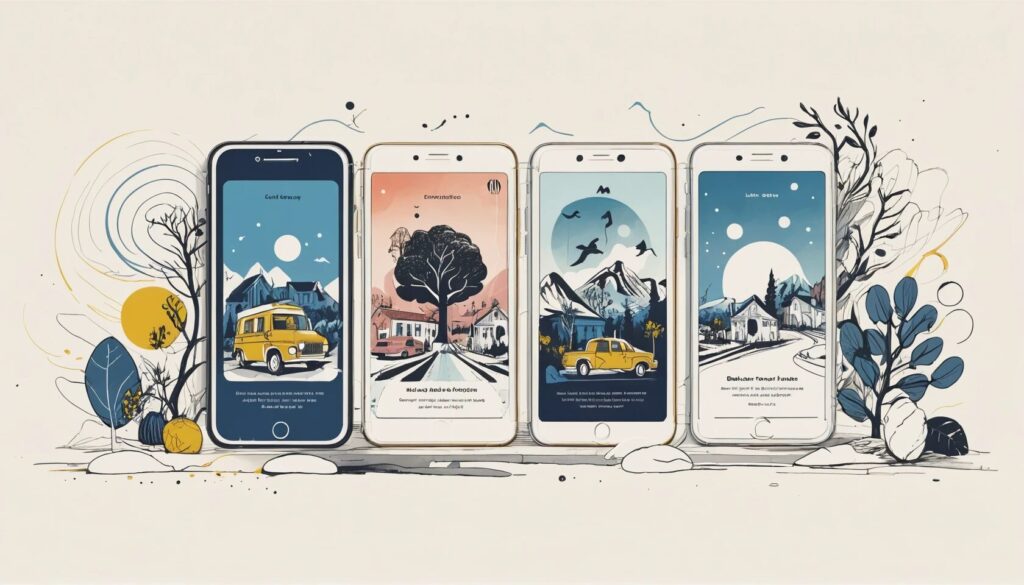Why Your Mobile Website Design Is a Make-or-Break Factor
- Over half of web traffic comes from mobile devices—ignore them at your own peril.
- Google’s mobile-first indexing means your mobile site now dictates your rankings.
- The best mobile website examples prove that speed, design, and usability are non-negotiable.
- Poor mobile optimization leads to high bounce rates and lost conversions.
Once upon a time, desktop websites ruled the internet. But that era is as dead as dial-up connections. Today, mobile website design isn’t just an option—it’s an absolute necessity. With 57% of global web traffic coming from mobile devices, failing to prioritize mobile-friendly design practices is like opening a store with no entrance.
And if you think Google will cut you some slack, think again. Thanks to mobile-first indexing, search engines judge your site based on its mobile version first. So if your mobile experience is a clunky, frustrating mess, your rankings will plummet faster than a buffering YouTube video.
Essential Mobile-Friendly Design Practices
- Adopt a mobile-first approach to ensure a seamless experience.
- Prioritize fast-loading pages by optimizing images and reducing scripts.
- Use responsive web design to adapt layouts to all screen sizes.
- Ensure intuitive navigation with accessible menus and clear CTAs.
- Implement touch-friendly elements to enhance usability.
The best mobile website examples don’t just shrink a desktop design down to size—they reimagine the experience entirely. A mobile-first approach means designing for smaller screens from the get-go, ensuring that essential elements remain front and center without unnecessary clutter.
Speed is another critical factor. If your site takes longer than three seconds to load, congratulations—you’ve just lost half your audience. Large, unoptimized images and excessive scripts are the usual culprits, so compressing media and enabling browser caching are must-dos.
Responsive web design ensures that layouts adjust fluidly across different devices. Nobody should have to pinch and zoom just to read a headline. Similarly, navigation should be effortless. A well-placed hamburger menu, sticky navigation, and prominent CTAs make a massive difference in usability.
Touch-friendly elements also matter. Buttons should be large enough to tap without frustration, and interactive elements should be spaced adequately to avoid accidental clicks. The best mobile website designs prioritize usability just as much as aesthetics.
Best Mobile Website Examples That Set the Standard
- S&W Beauty – Luxurious design with custom mobile navigation.
- Jonathan Van Ness – Bold branding and seamless user experience.
- In Print Art Book Fair – Engaging video backgrounds for instant immersion.
- Puffin Packaging – Eco-friendly storytelling with clean UI.
- Sharon Radisch – Minimalist yet highly functional design.
If you think mobile websites can’t be both stunning and functional, think again. S&W Beauty proves that luxury and usability can coexist, with high-end visuals and an intuitive layout that doesn’t sacrifice speed. Meanwhile, Jonathan Van Ness’s website is as vibrant and engaging as the personality it represents, guiding visitors effortlessly through its content.
For those who believe mobile sites can’t be interactive, In Print Art Book Fair shatters that myth with autoplaying video backgrounds that instantly engage visitors. Similarly, Puffin Packaging masterfully combines sustainability messaging with crisp, digestible content.
Minimalism lovers, take note—Sharon Radisch’s site is a lesson in how less can be more. With clean navigation and striking visuals, it proves that a mobile-friendly design doesn’t need bells and whistles to be effective.
How to Elevate Your Mobile Website Design
- Use large, readable fonts that don’t require zooming.
- Ensure buttons are spaced properly for easy tapping.
- Avoid intrusive pop-ups that disrupt the user experience.
- Enable smooth scrolling and back-to-top buttons for easier navigation.
- Test your site on multiple devices to catch usability issues.
Improving your mobile website design doesn’t require a tech wizard—just some common sense. Start with legible fonts. If users have to squint or zoom in to read, you’ve already lost them. Buttons should be large enough to tap without frustration, and pop-ups? Unless they’re critical, ditch them.
Another often-overlooked factor is scrolling. Mobile users expect effortless navigation, so smooth scrolling and a back-to-top button can make a world of difference. And before you pat yourself on the back, test your site on multiple devices—you’d be surprised how different it can look on various screens.
Upcoming Trends in Mobile Website Design
- Dark mode for improved aesthetics and battery efficiency.
- Voice search optimization as smart assistants gain traction.
- AI-driven personalization to enhance user engagement.
- Augmented reality (AR) for interactive shopping experiences.
- Gesture-based navigation replacing traditional buttons.
The future of mobile website design is looking anything but boring. Dark mode isn’t just a gimmick—it’s a game-changer for aesthetics and battery life, making it a must-have feature. Voice search is also on the rise, meaning websites must be optimized to accommodate natural language queries.
AI-driven personalization is another big shift. Imagine landing on a website that adapts its content based on your behavior before you even click anything. Meanwhile, AR is revolutionizing eCommerce, allowing users to preview products in their space before buying—a trend that’s only going to grow.
Gesture-based navigation is also creeping in, replacing traditional buttons with intuitive swipes and taps. As users become more accustomed to touch-based interactions, websites will need to adapt accordingly.
The Bottom Line
Ignoring mobile website design is no longer an option—it’s a guaranteed way to lose visitors, search rankings, and revenue. The best mobile website examples prove that a seamless, visually appealing, and fast-loading experience isn’t just possible—it’s expected.
By embracing mobile-friendly design practices, optimizing for speed, and staying ahead of emerging trends, you can ensure your site remains competitive. Whether it’s adopting a mobile-first approach or exploring AI-driven personalization, the future of mobile web design is evolving rapidly.
So take a critical look at your site today—because if you don’t, your users certainly will.
